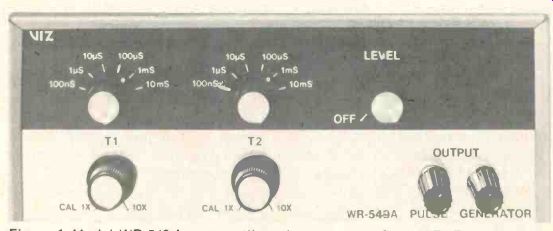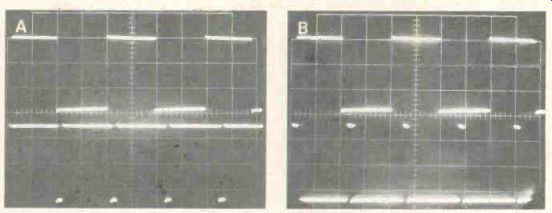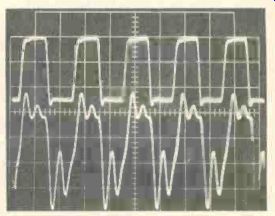By Carl Babcoke
In past years, a pulse generator was not needed for servicing electronic equipment. Sine or square waves were adequate for all audio applications. Even research laboratories did not always consider a pulse generator essential. But the requirements of test equipment have changed. and an adjustable pulse generator can be very helpful for checking both digital and analog circuits. Such a generator is the moderately priced VIZ model WR-549A.

Figure 1---Model WR-549 is a versatile pulse generator from VIZ. Each
one-shot pulse source has six possible duration times between 100nS and
10mS, selected by switches T1 and T2 (at top). The calibrations are correct
only when both variable controls (below) are turned to the X1 calibrate
positions (CCW).
Turning the controls clockwise lengthens the duration up to a maximum of almost X10. T1 determines the duration of each positive pulse, while T2 sets the duration of each zero-voltage space between positive pulses.

Figure
2---These waveforms show the effects of T1 and T2 adjustments. (A) The
top trace shows square waves of about 50Hz rep rate, produced by 10mS
of T1 and 10mS of T2. (Scope sweep was 5mS/div, so duration of each cycle
was slightly under 20mS or .02S. Rep rate is reciprocal of the time in
seconds.) Both the positive pulses and the zero voltage spaces between
have the same 20mS time duration. When the T2 switch has changed to 1
mS and T1 was not moved, the bottom-trace waveform shows the same duration
for the positive pulses. However, the zero spaces between have only 1/10
of the previous duration.
Sometimes these are called negative-going pulses, but that really applies only to ac waveforms. These are long-duration pulses. (Rep rate now is about 95Hz.) (B) Again the top trace shows 10mS/10mS square waves. When the T1 duration was decreased to 1 mS and T2 was not changed, the bottom trace shows narrow positive pulses of 1mS duration, while the zero spaces have the original 10mS duration. Total duration of one cycle is 11mS which is about 91Hz repetition. These are short duration dc pulses. In all these waveforms, zero dc volts is along the bottom. Without a load at the output, all pulses measured 12VPP.

Figure 3---CW rotation of T1
or T2 controls increases duration of that pulse. (A) The top trace
(20mS/div) showed T1 9.95mS and T2 10mS durations for a rep rate of about
50Hz. For the lower trace, T1 setting remained the same and T2 was turned
fully CW. This increased T2 to about 80ms for a new rep rate of about
12Hz. (B) These conditions started the same with 9.95mS and 10mS but
T1 control was turned fully CW, thus lengthening the T1 duration by almost
eight times the original

Figure 4---These waveforms show the critical importance of output cables
that match the circuit impedances, and of proper grounding for all fast
rise-time waveforms. Top trace shows 4.7MHz square waves viewed on a
good-quality 35MHz scope, while the bottom trace with the ringing and
incorrect increase of amplitude was made without any change of scope
settings but with an external ground between scope and generator instead
of grounding through the scope probe clip. The generator has no noticeable
ringing, but poor interconnecting wiring can add them. In the lower trace,
notice the slight FM (sideways movement) effect at the right when the
ground was bad.
Pulse-generator features
Two six-position switches and two variable controls determine the duty cycle and repetition rate of output signals from the VIZ WR 549A. Also on the front panel are an on/off/level control and twin binding posts for the output signal.
The instrument is powered from the ac line and draws only 5W.
Square waves between approximately 2.5Hz and 5MHz can be obtained by adjustment of the four controls. Pulses have a more restricted range. for the limits depend on the duty cycle. The repetition range should be more than adequate for any servicing application.
However, the repetition rate often is of lesser importance than is the on time or the duty cycle. All can be measured by a scope.
In digital language, the rise and fall times are 20nS (0.02/4S) or faster. and the minimum output level should be SVPP with a load of 10 transistor-transistor logic gates (10 TTL fanouts).
This good performance and simple operation requires one trade-off: It is essential for the operator to have knowledge of how the WR-549A generates pulses and how to measure them with a triggered scope.
Two one-shots in sequence
Instead of a single tunable oscillator and variation of the pulse width, the WG-549A has two separate one-shots that operate in sequence. Each can be adjusted for duration. The trailing edge of the first one-shot pulse triggers the second one-shot. Then the pulse's trailing edge from the second triggers the first again, and so on in a continuous series of pulses.
Settings of the six-position T1 switch and the X1/X10 variable control (see Figure 1) determine the time duration of the first one-shot.
The switch provides fixed times and the control allows continuous (but uncalibrated) increases of those times. T2 switch and its associated control do the same for the second one-shot.
The first one-shot provides the positive segment of the generator output signal, while the second one-shot produces a time of zero voltage. In other words, the genera tor has no coupling capacitors; the output either is maximum dc voltage or zero voltage. (An external coupling capacitor can be connected if needed for a specific application.) Therefore, the generator signal has true digital positive pulses for high states and zero voltage for digital lows. The timed duration of both highs and lows are independently adjustable.
Waveforms show operation
Figure 2 shows how long-duty-cycle (negative-going) pulses and short-duty-cycle (positive-going) pulses are created by reversing the settings of T1 and T2 switches.
Remember that the variable time controls must be turned to the X1 (CCW) position if the precise (with in ± 5%) time selected by T1 or T2 is needed. Other positions of these controls are uncalibrated.
During tests of the sample generator. the marked times of T1 and T2 were increased by a factor of about nine when the controls were rotated to maximum (clockwise), as shown in Figure 3. Any duty cycle between the two traces of each picture can be obtained by inter mediate settings of the appropriate variable control.
Average dc output voltage
Output of the WR-549A genera tor is direct from an emitter follower without a coupling capacitor. Therefore, the measured dc voltage at the output varies with the level-control setting and the waveform's duty cycle. With the level control at maximum, square waves produced +6.36 and 13VPP, 1:10 ratio pulses gave +1.24V, 1:100 ratio gave +0.168V. while 10:1 ratio produced +11.74V. and 100:1 ratio gave +12.86V. These readings were recorded while a digital meter was the only output load. Lower-resistance loads decreased the wave form amplitude and the dc-voltage reading. No changes of waveshape were noted when the load was varied.
Undesired waveform changes
Square waves and pulses with fast rise times are susceptible to ringing and other distortions from improper termination impedances or tortuous ground returns. Figure 4 top trace shows the normal square waveform at 4.7MHz (highest rep rate for this sample instrument) when the scope probe was connected properly with the probe ground used at the generator. In contrast, the lower trace shows the increased amplitude and excessive ringing that resulted from using a separate ground between scope and generator. Of course, ringing is resonance that requires capacitance and inductance. Both are supplied by ground and probe wires during mismatched operation.
The generator is free of these resonances, but care must be used when it is used to drive other equipment. Digital-logic circuits (including frequency counters) give false results when fed by distorted waveforms such as the lower trace of Figure 4.
Applications:
The following are some applications of the VIZ WR-549A pulse generator:
a substitute for a digital clock;
signal source for testing CMOS.
RTL or TTL logic circuits;
source of signal for pulse modulation of LEDs or lasers;
test signal for pulsed servo systems and transponders or switching regulators;
adds pulses to dc power supplies to test the transient response;
shock excitation of mechanical devices to determine resonant point;
signal source for testing ultra sonic transducers;
can be a signal source for generating sawteeth and other waveforms.
This model WR-549A VIZ pulse generator should be very useful for these and other applications. It performed excellently during the lab tests.
Also see: Calculating service labor rates